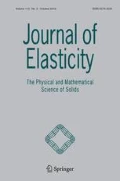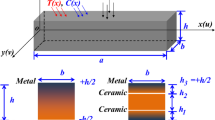Abstract
An isotropic elastic strip, with a continuous inhomogeneity profile for Young’s modulus is considered, subject to a self-equilibrated load on one of its axial ends and free of traction on the remainder of its surface boundaries. By taking advantage of the analytical flexibility of an exponential inhomogeneity profile, the full equations of linear theory of elasticity are employed to find the two-dimensional Saint-Venant decay rate in terms of an inhomogeneity parameter that measures gradation steepness in a Functionally Graded Material (FGM). The results show that softening axial inhomogeneity may be introduced to engineered FGM strips and beams to accelerate the decay of stresses. For a hardening axial inhomogeneity on the other hand, the end effects extend beyond a one-width-size distance from the loaded end. The plane problem end effects are shown to decay faster compared to the anti-plane shear counterparts, consistent with what is observed in homogeneous media. For inhomogeneity in the lateral direction from the core toward the outer edges, the qualitative behaviour changes with the degree of inhomogeneity. Whether the core is softer or harder relative to the outer edges, a steep lateral gradation of elastic modulus can significantly increase the decay length of end effects.


Similar content being viewed by others
References
Anlas, G., Lambros, J., Santare, M.H.: Dominance of asymptotic crack tip fields in elastic functionally graded materials. Int. J. Fract. 115(2), 193–204 (2002)
Bartlett, N.W., Tolley, M.T., Overvelde, J.T., Weaver, J.C., Mosadegh, B., Bertoldi, K., Whitesides, G.M., Wood, R.J.: A 3d-printed, functionally graded soft robot powered by combustion. Science 349(6244), 161–165 (2015)
Baxter, S.C., Horgan, C.O.: End effects for anti-plane shear deformations of sandwich structures. J. Elast. 40(2), 123–164 (1995)
Baxter, S.C., Horgan, C.O.: Anti-plane shear deformations of anisotropic sandwich structures: end effects. Int. J. Solids Struct. 34(1), 79–98 (1997)
Biria, A., Mandre, S., Venkadesan, M.: Mechanobiology of the ligament to bone insertion. Biophys. J. 112(3), 433 (2017)
Borrelli, A., Horgan, C.O., Patria, M.C.: Exponential decay of end effects in anti-plane shear for functionally graded piezoelectric materials. Proc. R. Soc. Lond. Ser. A 460(2044), 1193–1212 (2004)
Chan, A.M., Horgan, C.O.: End effects in anti-plane shear for an inhomogeneous isotropic linearly elastic semi-infinite strip. J. Elast. 51(3), 227–242 (1998)
Chen, Y.F., Erdogan, F.: The interface crack problem for a nonhomogeneous coating bonded to a homogeneous substrate. J. Mech. Phys. Solids 44(5), 771–787 (1996)
Choi, I., Horgan, C.O.: Saint-Venant end effects for plane deformation of sandwich strips. Int. J. Solids Struct. 14(3), 187–195 (1978)
Delale, F., Erdogan, F.: Interface crack in a nonhomogeneous elastic medium. Int. J. Eng. Sci. 26(6), 559–568 (1988)
Flavin, J.N.: Spatial-decay estimates for a generalized biharmonic equation in inhomogeneous elasticity. J. Eng. Math. 46(3–4), 241–252 (2003)
Gu, P., Asaro, R.J.: Cracks in functionally graded materials. Int. J. Solids Struct. 34(1), 1–17 (1997)
Guo, L.C., Noda, N.: Modeling method for a crack problem of functionally graded materials with arbitrary properties—piecewise-exponential model. Int. J. Solids Struct. 44(21), 6768–6790 (2007)
Hemleben, S.: Modeling a spectrum of 3d printed materials for soft robots. Master’s thesis, Oregon State University, United States (2017)
Horgan, C.O.: Recent developments concerning Saint-Venant’s principle: an update. Appl. Mech. Rev. 42(11), 295–303 (1989)
Horgan, C.O.: Recent developments concerning Saint-Venant’s principle: a second update. Appl. Mech. Rev. 49(10S), S101–S111 (1996)
Horgan, C.O., Carlsson, L.A.: Saint-Venant end effects for anisotropic materials. In: Beaumont, P., Zweben, C. (eds.) Comprehensive Composite Materials II, vol. 7, pp. 38–55. Oxford Academic Press, Oxford (2018). Chap. 7.3
Horgan, C.O., Knowles, J.K.: Recent developments concerning Saint-Venant’s principle. In: Advances in Applied Mechanics, vol. 23, pp. 179–269. Elsevier, Amsterdam (1983)
Horgan, C.O., Miller, K.L.: Antiplane shear deformations for homogeneous and inhomogeneous anisotropic linearly elastic solids. J. Appl. Mech. 61, 23 (1994)
Horgan, C.O., Payne, L.E.: On the asymptotic behavior of solutions of linear second-order boundary-value problems on a semi-infinite strip. Arch. Ration. Mech. Anal. 124(3), 277–303 (1993)
Horgan, C.O., Quintanilla, R.: Saint-Venant end effects in antiplane shear for functionally graded linearly elastic materials. Math. Mech. Solids 6(2), 115–132 (2001)
Kashtalyan, M.: Three-dimensional elasticity solution for bending of functionally graded rectangular plates. Eur. J. Mech. A, Solids 23(5), 853–864 (2004)
Knowles, J.K.: On Saint-Venant’s principle in the two-dimensional linear theory of elasticity. Arch. Ration. Mech. Anal. 21(1), 1–22 (1966)
Kovalenko, M.D., Shulyakovskaya, T.D.: Expansions in Fadle-Papkovich functions in a strip. Theory foundations. Mech. Solids 46(5), 721–738 (2011)
Leseduarte, M.C., Quintanilla, R.: Saint-Venant decay rates for a non-homogeneous isotropic mixture of elastic solids in anti-plane shear. Int. J. Solids Struct. 42(9–10), 2977–3000 (2005)
Leseduarte, M.C., Quintanilla, R.: Saint-Venant decay rates for an anisotropic and non-homogeneous mixture of elastic solids in anti-plane shear. Int. J. Solids Struct. 45(6), 1697–1712 (2008)
Leseduarte, M.C., Quintanilla, R.: Lower bounds of end effects for a nonhomogeneous isotropic linear elastic solid in anti-plane shear. Math. Mech. Solids 20(2), 140–156 (2015)
Leseduarte, M.C., Quintanilla, R.: Decay rates of Saint-Venant type for a functionally graded heat-conducting hollowed cylinder. Math. Mech. Solids 24(5), 1368–1386 (2019)
Leseduarte, M.C., Quintanilla, R.: Decay rates of Saint-Venant type for functionally graded heat-conducting materials. Int. J. Eng. Sci. 139, 24–41 (2019)
Li, X., Xie, J., Lipner, J., Yuan, X., Thomopoulos, S., Xia, Y.: Nanofiber scaffolds with gradations in mineral content for mimicking the tendon-to-bone insertion site. Nano Lett. 9(7), 2763–2768 (2009)
MATLAB (2016) version 9.0 (R2016a). The Mathworks Inc., Natick, MA, United States
Miller, K.L., Horgan, C.O.: Saint-Venant end effects for plane deformations of elastic composites. Mech. Compos. Mater. Struct. 2(3), 203–214 (1995)
Oleinik, O.A., Yosifian, G.A.: Boundary value problems for second order elliptic equations in unbounded domains and Saint-Venant’s principle. Ann. Sc. Norm. Super. Pisa, Cl. Sci. 4(2), 269–290 (1977)
Rahbar, N., Soboyejo, W.O.: Design of functionally graded dental multilayers. Fatigue Fract. Eng. Mater. Struct. 34(11), 887–897 (2011)
Scalpato, M.R., Horgan, C.O.: Saint-Venant decay rates for an isotropic inhomogeneous linearly elastic solid in anti-plane shear. J. Elast. 48(2), 145–166 (1997)
Tan, Y., Hoon, S., Guerette, P.A., Wei, W., Ghadban, A., Hao, C., Miserez, A., Waite, J.H.: Infiltration of chitin by protein coacervates defines the squid beak mechanical gradient. Nat. Chem. Biol. 11(7), 488 (2015)
Timoshenko, S., Goodier, J.N.: Theory of Elasticity. McGraw Hill, New York (1970)
Toupin, R.A.: Saint-Venant’s principle. Arch. Ration. Mech. Anal. 18(2), 83–96 (1965)
Waite, J.H., Lichtenegger, H.C., Stucky, G.D., Hansma, P.: Exploring molecular and mechanical gradients in structural bioscaffolds. Biochemistry 43(24), 7653–7662 (2004)
Yang, Q., Zheng, B., Zhang, K., Zhu, J.: The eigenvalue problem and Saint-Venant decay rate for a nonhomogeneous semi-infinite strip. Acta Mech. Solida Sin. 27(6), 588–596 (2014)
Acknowledgements
Financial support from National Science and Engineering Council of Canada through the Postdoctoral Fellowship PDF - 488169 is appreciated, as well as fruitful discussions with Professors Lyes Kadem and Brian Seguin. The author is grateful to the reviewers and to Professor C. O. Horgan for their helpful comments on an earlier version of the manuscript.
Author information
Authors and Affiliations
Corresponding author
Additional information
Publisher’s Note
Springer Nature remains neutral with regard to jurisdictional claims in published maps and institutional affiliations.
Appendices
Appendix A: Derivation of Compatibility Equation for an Inhomogeneous Isotropic Material
The two-dimensional compatibility equation requires strains to satisfy
In view of (3), the plane-stress constitutive assumptions in terms of the Airy stress function \(\phi \), for an isotropic material with inhomogeneity in the form \(E=E(x_{1},x_{2})\), is given by
Inserting (44) in the compatibility equation (43) yields
which upon introducing the two-dimensional Laplace operator \(\Delta = \partial _{11}+\partial _{22}\) simplifies to
This is the governing equation (4).
Appendix B: Determining the Sign of \(p\) from \(p^{2}-4q>0\) in (18)
Recall the definitions of \(p\) and \(q\) given by (15):
by which
and since \(\nu \) is nonnegative by definition, if \(p^{2}-4q>0\), it follows that
Now if \(m(m+\gamma )>0\), then \(2m(m+\gamma )<4m(m+\gamma )\), so that
by which
If on the other hand \(m(m+\gamma )\le 0\), \(p\) is negative or zero on account of being the sum of two nonpositive terms by its definition (47)1, irrespective of the sign of \({p^{2}-4q}\). As a result, \({p^{2}-4q>0}\) always implies that \(p\) is either negative or equal to zero.
Appendix C: Analysis of Equation (22)
a) If the roots \(\alpha _{1}\) and \(\alpha _{2}\) given by (18) are complex conjugate (\(p^{2}-4q<0\)):
Define the roots in terms of real numbers \(a\) and \(b\) as \(\alpha _{1}=a+ib\) and \(\alpha _{2}=a-ib\). Then, with the expansions
equation (22) yields
by which either \(a\) or \(b\) should vanish, leading to \(\alpha _{1}=\pm \alpha _{2}\).
b) If the roots \(\alpha _{1}\) and \(\alpha _{2}\) given by (18) are real (\(p^{2}-4q>0\)):
Consider the function \(\bar{f}(x)=x\tanh (x)\). It can be easily verified that it satisfies the following:
-
\(\bar{f}'(x)>0 \) for \(x>0\), so \(\bar{f}\) is increasing for \(x>0\)
-
\(\bar{f}'(x)<0 \) for \(x<0\), so \(\bar{f}\) is decreasing for \(x<0\)
-
\(\lim _{x \to \pm \infty } \bar{f}(x)=\infty \)
-
\(\bar{f}(x)>0\) for \(x\ne 0\).
From these properties and the intermediate value theorem, we have that for any \(L>0\), there are unique numbers \(a>0\) and \(b<0\) such that \(L=\bar{f}(a)=\bar{f}(b)\). Moreover, for any \(x\), \(\bar{f}(x)=\bar{f}(-x)\). It follows that equation (22), or its equivalent \(\bar{f}(w\alpha _{1})=\bar{f}(w\alpha _{2})\), leads to \(\alpha _{1}=\pm \alpha _{2}\).
Rights and permissions
About this article
Cite this article
Biria, A. Saint-Venant End Effects in the Plane Problem for Linearly Elastic Functionally Graded Materials. J Elast 142, 121–134 (2020). https://doi.org/10.1007/s10659-020-09792-7
Received:
Published:
Issue Date:
DOI: https://doi.org/10.1007/s10659-020-09792-7




